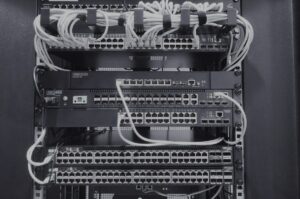Buying a data center switch for your network can be a complicated task. However, if you can get some clear answers to these questions below, you will be one step closer.
• What kind of devices will you be connecting?
• What is your budget?
• What level of skills do you have in house to deploy and maintain your network?
• Do you need core switching?
• What are bare metal switches?
Traditional vs Bare Metal / White Box Switches
A core switch (also known as a tandem switch or backbone switch) is a high-capacity switch generally positioned within the backbone or physical core of a network.
As the name implies, a core switch is central to the network and needs to have a significant capacity to handle the load sent to it. In the design of a network, the core layer is not required in smaller networks – however, it is necessary for medium to large networks. The high-capacity core switch plays an important role in delivering packets as fast as possible in the center of the network.
There are many different switching vendors on the market. One of the most well known is Cisco. A Cisco 300 series switch, for example, includes a web-based, command line, and/or SNMP management interface that allows you to monitor network traffic and troubleshoot problems. Other advanced features include support for IPv6 for user traffic and management; built-in-quality-of-service controls to keep applications running smoothly and security capabilities such as BPDU Guard, DOS prevention, and advanced ACLs to keep the network secure.
Edgecore switches are different from traditional vendors like Cisco. While they offer similar capabilities in terms of connectivity, their user interface is based on an open standard. This open standard makes them significantly easier to use and operate with less personnel, reducing an organizations OPEX. The hardware/software combination is also far less expensive than the equivalent Cisco options, which significantly reduces an organizations CAPEX.
Knowledge Requirements for Traditional Vendors Like Cisco
Cisco offers a detailed education path for engineers and technicians interested in working on their equipment. The foundation level is the CCNA or Cisco Certified Network Associate.
CCNA graduates learn how to install, configure, operate and troubleshoot medium-size route and switched networks. Training also includes basic mitigation of security threats, introduction to wireless networking concepts and terminology, and performance-based skills. Ever since the CCNA program began, Cisco certifications have been coveted by networking companies and businesses in general. A Cisco CCNA Routing and Switching certification provide you with the knowledge and expertise to succeed in networking, even as technologies continue to evolve.
While the certification is definitely beneficial, it is expensive to obtain and can be quite time consuming as students transition through the levels. It is possible to maintain Cisco hardware without this training, but due to the complexity of the interface it is not recommended.
Making the Switch from Cisco to Edge-Core
IT managers are considering Edgecore switches for a variety of different reasons listed below.
• Sizing and Function – there is a broad variety of merchant silicon, speed and port density to choose from based on the requirements of each business and its user base. This provides IT managers an array of option in terms of footprint and price point.
• Price – perhaps the most relevant argument in an IT managers decision is the significant savings on OPEX and CAPEX. Edgecore switches offer the most commonly used features that are needed by a business. Since they are built using open source software instead of a proprietary system, they are significantly cheaper in terms of acquisition and deployment costs. The NOS software as well as optics from top tier vendors like Finisar and Amphenol can provide the same quality as traditional vendors at a lower price point.
• Ease of use – since the switches are based on open software, it is not necessary to go through a complicated training regime prior to working on the equipment. Also, the software selection in the open networking model is much more flexible allowing you to pay only for what you need. There has been some uneasiness in the industry due to real and perceived lack of support – however, this has been recognized and now remedied by the industry with many suppliers providing end-to-end support services.
Edge-core bare metal switches may be a good solution for your business. The right solution for your organization depends on your needs, requirements and budget.
Hardware Nation is an open networking solutions provider. We have the expertise in-house to help you choose the right solution that suits your business. Our experts can work with you on identifying all of your needs and help you build a customized solution that will help achieve your objectives. We can also provide complete solutions that include switches, software, optics, integration and deployment services.




